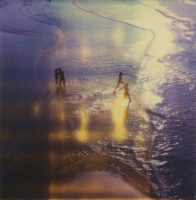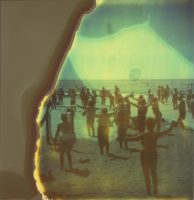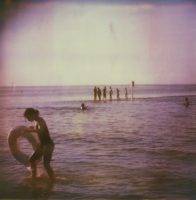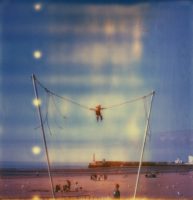
Following from the recent publication of her book Dreamlands/Wastelands (reported here last month), which comprises of captivating dreamlike seaside images through expired Polaroid film, we speak to Shutter Hub member Rhiannon Adam to find out more about her journey as a photographer, her work and inspirations.
Who are you?
I’m Rhiannon Adam and I’m a photographer, mostly specialising in Polaroid. I was born in Ireland, then sailed on a 40ft boat with my parents for years around the Caribbean and South America, and I’ve been living in the UK for about 15 years now. All the travelling has had a huge influence on my photography – we never took pictures when I was young, and it seems as though I am making up for lost time. I think my interest in Polaroid really comes from the idea of it being an object as well as a photograph – a true souvenir, something that was born in the place that the picture shows – part of it. A unique thing that is forever tied to where it same from with a personality far bigger than the scene pictured.
When did you first discover your interest in photography?
Well, as I say, growing up we didn’t take pictures. There are very few images from our time on the boat, and these have mostly been gathered from other people who floated around in and out of our lives at that time. Many of the pictures from my childhood pre-sailing were ruined by humidity and stuck together and I only have a few retrieved from my grandmother’s house. It is like my personal history stopped at a certain point.
I think missing that is what spurred my interest on though. When I was in secondary school, Francis Holland in London, I really fell in love with photography. I was always big into art, and I really liked installation and video, things that were clean and neat. I was really influenced by Andy Warhol and Barbara Kruger in the early days – graphic and clean. Then I discovered the darkroom and the rest is history. I became obsessed with it, running photography club and spending all my lunch times locked away experimenting with compositing and printing things onto acetate to process in the darkroom. I loved the experimentation.
My first Polaroid camera was given to me just after I had completed work experience at a TV production company. The director I was working with had access to a film cupboard that they had used for reference and continuity and he used to send me free film all of the time. It was only a basic camera but I started to record anything and everything as though I never wanted to miss a memory again. It also fitted in nicely with my love of neatness and the graphic qualities given the square frame… I became a bit of an addict, writing my A-Level dissertation on Polaroid, and then going on to collect every camera I could lay my hands on.
Where did it go from there?
When I finished school I went to Central Saint Martins – I studied Art and Design and skipped doing a foundation course. For some reason they allowed me straight on to a degree course after having an interview for the foundation, and so I skipped a year. I had a place waiting for me at Cambridge University for deferred entry and so I told them I didn’t want it, and headed off to Saint Martins. But I hated it and I didn’t end up finishing the degree then. I then begged for my place back at Cambridge using the proviso that it had been a place for deferred entry anyway so that they couldn’t possibly have known who my competitors were. After MUCH deliberation, they let me back in without having to reapply, so I went there and studied English. A bit of a change…
I never had any formal photographic training, but I carried on running a darkroom in my college, and shot for the student newspaper, and carried on with graphic and design while there. My girlfriend at the time was quite a bit older than me, and an art director and was hugely encouraging, and really helped me to work out what I wanted to do. Though we split up while I was studying, I think I really owe most of it to her, as she set me on the right path and gave me books to read and showed me things I wouldn’t have seen otherwise.
What was your first job?
My first job is a hard one – I was always a bit of a Del Boy. Fingers in many pies! Even as a kid I was resourceful – selling grey mullet to Moroccans in Gibraltar, making bead bracelets and hustling them… I offered my services doing just about anything.
I suppose my first ‘proper’ full-time job though was working as an editorial assistant for an online community website for sailors – sort of fitting. I did that in summers. I never told them I hated sailing and blagged a love of fishing in my interview, as they had a fishing website amongst their portfolio… somehow I got the job and they paid me pretty well for what it was. I actually took a pay cut for my next job!
Best and worst parts of this?
The best bit? Well, I suppose being paid, and doing something that was very straightforward that I cold do standing on my head. The worst part? The fact it was full time, and that I could do it standing on my head. Something the best things and the worst things are one and the same.
How did you get from your first job, to where you are now?
To be honest I have no idea… I plugged away and tried different things. I knew what area I wanted to work in and I applied and applied – mostly for things within TV, film and publishing. I always loved books – mostly down to sailing again – and books being the only source of information. Hen we didn’t have TV or radio, or the internet, books were a form of solace.
I landed a job in the design department at Thames and Hudson straight out of Cambridge, and that was a great place to work. I saw what books were being made, got to work with great people, and it taught me what I did and didn’t like about photography in many ways. Publishing just doesn’t pay you enough though and I was getting into debt working full time, so I applied for other jobs one Monday, and then by Friday I had a new job working for a photo agent in advertising. I am not really a fan of advertising photography but thank to my first girlfriend being an art director, I knew a job about the industry. I was working with photography every day, but not the sort of work I liked particularly, and eventually (I am cutting a lot of the story out here!) I went freelance to do my own thing photographically.
I’d been working on my own alongside my job, and I had been exhibiting a lot. I’d been published a lot too. The polaroid photographic community is small and tight, and very supportive. So many opportunities came my way and I guess I was very determined too. It came naturally, but with a lot of hard graft. A lot of knock backs. There was this website, www.polanoid.net that really changed everything for me – like flickr but only for polaroid. That’s where I met a lot of people, and this eventually became the Impossible Project, who now produce compatible film. I guess many of my contacts and support network was grown there. I am moving away from the strictly Polaroid community now, but yeah… I guess that’d how I got here.
What work of yours would you say best represents you and your practice?
I guess a lot of my work is about me in a way, it’s autobiographical. I shoot a lot about “Britishness” – in a way it’s about trying to fit in to this place I call home, by understanding it better. I usually feel like an outsider wherever I am – that’s what comes from travelling a lot. I have a very fluid sense of my own identity and so most of my work that “best represents” me reflects this – I shoot people from far away, as though I am looking through binoculars at the world, like I did as a child, peering in but never a part of the action.
My emulsion lift work is another aspect that is quite representative – these are very organic pieces, slightly unpredictable and in some ways mirror the way I see the world. How places and associations melt together, and one memory leads on to another. One things reminds you of something else – we all exist in a lot of places at the same time. It’s hard to be present in the here and now, and I think these pieces reflect the schizophrenia of everyday life, hidden behind a calm exterior.
Your website also mentions that you have published books under the name 'Lost Cat'. Tell us more about that.
Yes, my friend, Kate Slotover and I started Lost Cat, and last year we published our first book. It’s a title by Kevin Griffin – called Omey Island : Last Man Standing about a former Hollywood stunt man who now lives as a virtual recluse and is the only remaining resident of Omey Island, off the West coast of Ireland. The story resonated with me and I love Kevin’s pictures. We printed 1000 copies of it, and I was really involved in everything to do with the project. I love being able to make something from nothing – curating a book, designing it, turning it into a narrative that is bigger than the sum of its parts. I don’t know what we’ll do next, but I’m really looking forward to it.
You are obviously inspired by polaroid photography (even your website is called 'save-polaroid'!). What is it about that medium that appeals to you?
I think I’ve already touched on this – but really it’s about uniqueness, and tangibility. Each one is an isolated moment that could never be recreated even a second later. Polaroids are process and completed on site, there is no one else involved in the process. It’s pure – just me, the camera and the film. No one looking over your negatives, no changing it after it was shot. If I frame it badly, I frame it badly. It’s sort of fatalistic.
They also hold their chemistry with them so they really become a part of the place where they were shot. They take on the characteristics of the place. If it’s warm, or cold, or humid the image will look different. I can examine one from 1970 like an archaeologist and tell you so much more about the time it was taken that what is simply visible within the frame. A Polaroid alludes to the world outside of the image and as such it’s a more complete “picture”. The act of shooting one cements the moment in time, and experiencing the development is like magic. It’s like nothing else I know, possibly closer to painting than photography…
Who do you admire?
I admire people who have a strong sense of who they are and don’t care what other people think of their actions or work. I don’t seek approval and I admire people who don’t either. They vary – from Tilda Swinton (genius, powerhouse), to Bjork, Nanci Griffith (folk/country singer who has been around forever), and Yayoi Kusama to photographers like Nan Goldin, Rinko Kawauchi, Ryan McGinley, and Sally Mann. I admire anyone who makes their creativity work for them, and can harness it effectively.
What gives you most satisfaction in your work, and are there any jobs or achievements which you are especially proud of?
Being my own boss – the freedom of it all. I’m proud of having gotten this far against the odds. Every day I wake up and can’t believe that I am basically doing what I always wanted to do. Sure, I have off days and doubts, but doing what I want to do on a daily basis is the biggest achievement of them all.
What would you like to achieve in the future?
I’d like to do another book project over the next couple of years, and there are new places to travel to – I really want to go to Pitcairn in the Pacific. It’s the last remaining British overseas territory there and I’d like to do a big project on the island. I’d like to stage an exhibition there and then bring it back to the UK. There are so many things I want to do it’s hard to know where to start. I suppose more than anything I’d like to stay happy, and stay working on things that make push me every day…
You can see more of Rhiannon's work on her Shutter Hub profile, and find out more about her work at her website, here.
Is there someone that you’d really like to see us interview on Shutter Hub? Drop us a line and let us know!






